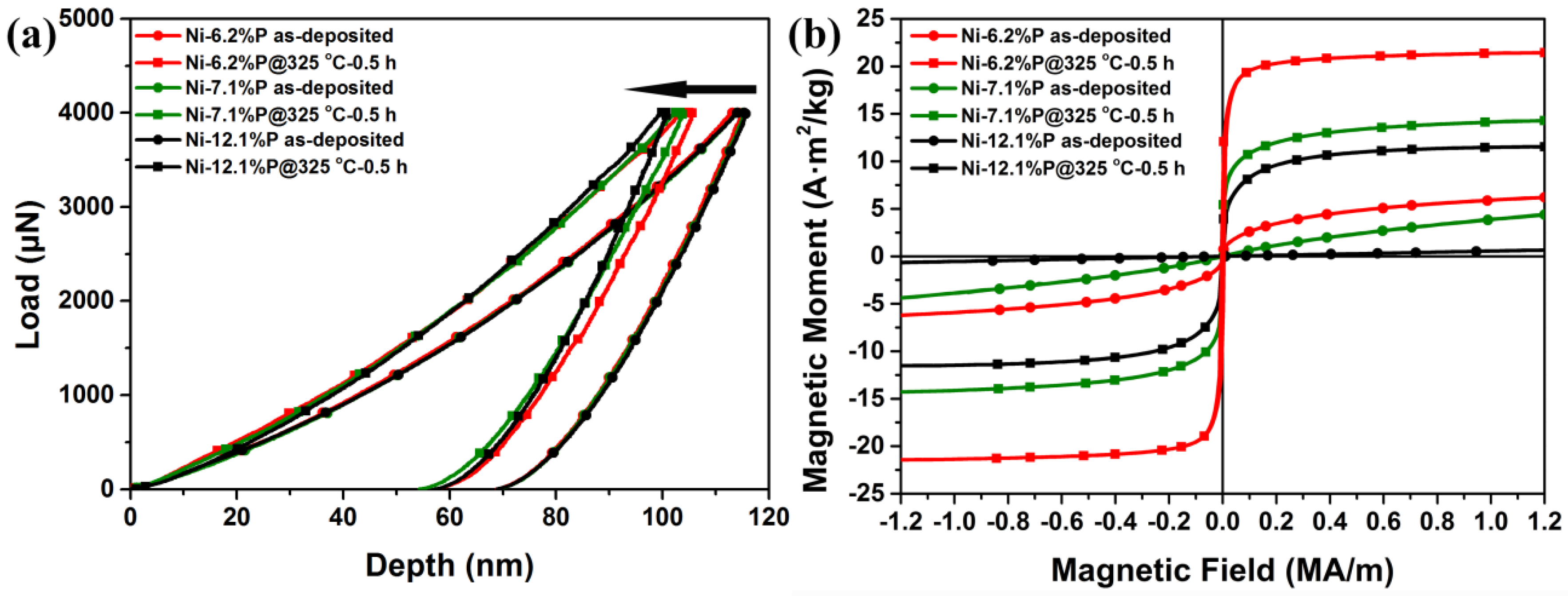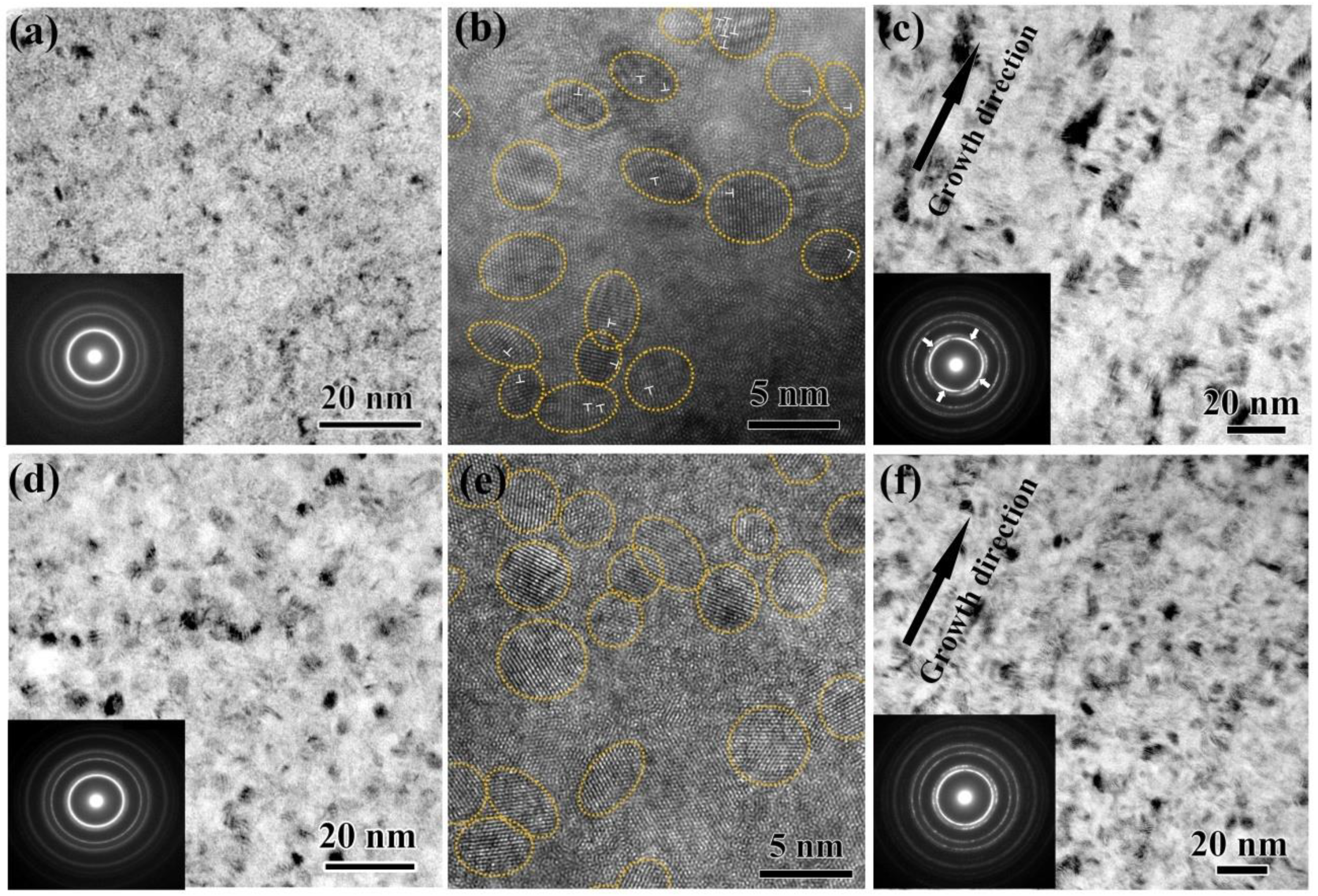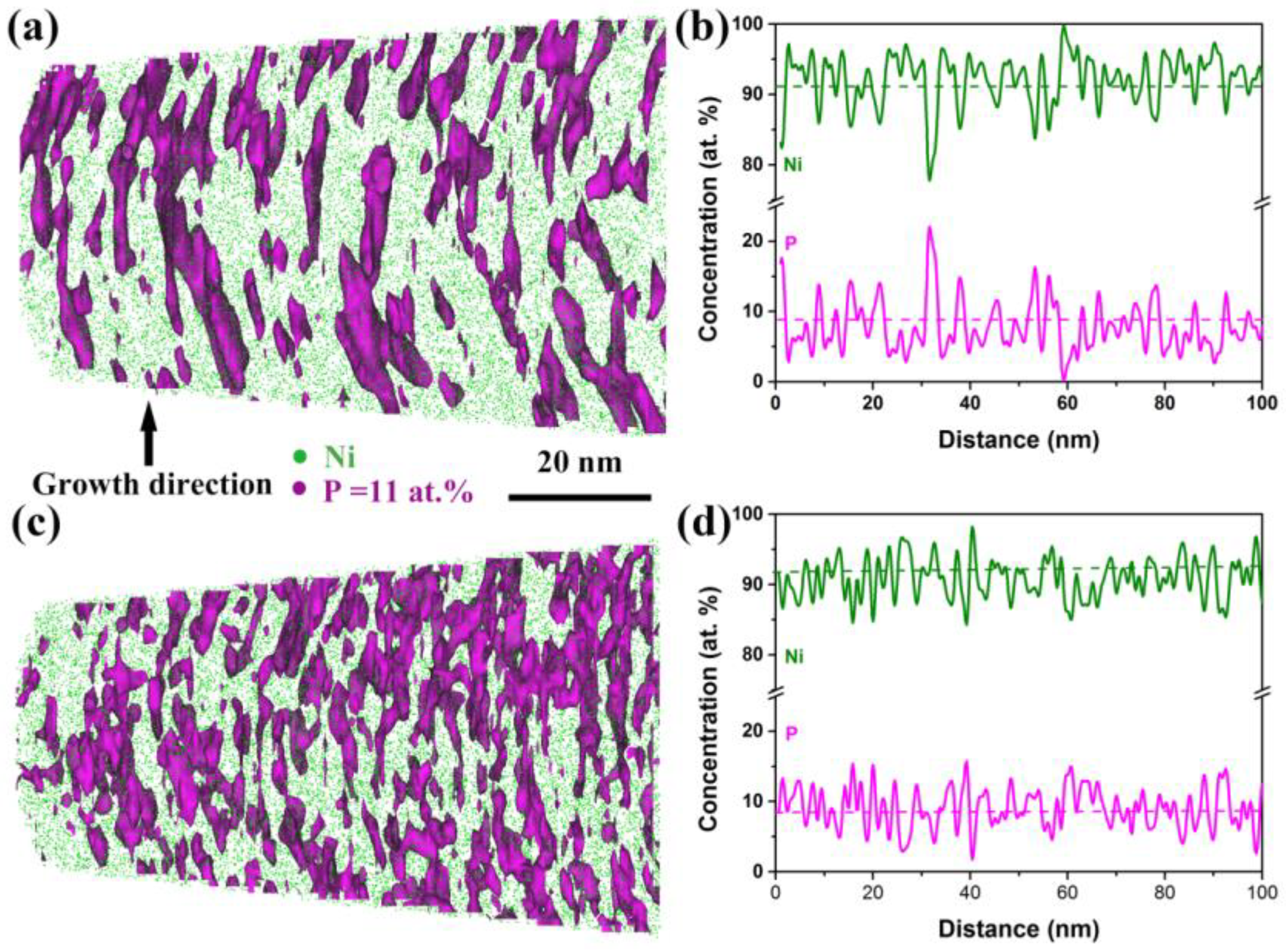Simultaneous Enhancement of Mechanical and Magnetic Properties in Extremely-Fine Nanograined Ni-P Alloys
Abstract
:1. Introduction
2. Materials and Methods
3. Results and Discussions
4. Conclusions
Author Contributions
Funding
Acknowledgments
Conflicts of Interest
References
- Kumar, K.S.; Van Swygenhoven, H.; Suresh, S. Mechanical behavior of nanocrystalline metals and alloys1. Acta Mater. 2003, 51, 5743–5774. [Google Scholar] [CrossRef]
- Wolf, D.; Yamakov, V.; Phillpot, S.R.; Mukherjee, A.; Gleiter, H. Deformation of nanocrystalline materials by molecular-dynamics simulation: relationship to experiments? Acta Mater. 2005, 53, 1–40. [Google Scholar] [CrossRef]
- Rane, G.K.; Welzel, U.; Mittemeijer, E.J. Grain growth studies on nanocrystalline Ni powder. Acta Mater. 2012, 60, 7011–7023. [Google Scholar] [CrossRef]
- Mchenry, M.E.; Laughin, D.E. Nano-scale materials development for future magnetic applications. Acta Mater. 2000, 48, 223–238. [Google Scholar] [CrossRef]
- Herzer, G. Modern soft magnets: Amorphous and nanocrystalline materials. Acta Mater. 2013, 61, 718–734. [Google Scholar] [CrossRef]
- Sulitanu, N. Structural origin of perpendicular magnetic anisotropy in Ni–W. thin films. J. Mag. Mag. Mat. 2001, 231, 85–93. [Google Scholar] [CrossRef]
- Myung, N.V.; Park, D.Y.; Yoo, B.Y.; SumodjoP, T.A. Development of electroplated magnetic materials for MEMS. J. Mag. Mag. Mat. 2003, 265, 189–198. [Google Scholar] [CrossRef] [Green Version]
- Jang, D.; Atzmon, M. Grain-boundary relaxation and its effect on plasticity in nanocrystalline Fe. J. Appl. Phys. 2006, 99, 083504. [Google Scholar] [CrossRef]
- Huang, J.Y.; Zhu, Y.T.; Jiang, H.; Lowe, T.C. Microstructures and dislocation configurations in nanostructured Cu processed by repetitive corrugation and straightening. Acta Mater. 2001, 49, 1497–1505. [Google Scholar] [CrossRef] [Green Version]
- Löffler, J.; Weissmüller, J. Grain-boundary atomic structure in nanocrystalline palladium from X-ray atomic distribution functions. Phys. Rev. B 1995, 52, 7076–7093. [Google Scholar] [CrossRef]
- Vo, N.Q.; Averback, R.S.; Bellon, P.; Caro, A. Yield strength in nanocrystalline Cu during high strain rate deformation. Scr. Mater. 2009, 61, 76–79. [Google Scholar] [CrossRef]
- Rupert, T.J.; Trelewicz, J.R.; Schuh, C.A. Grain boundary relaxation strengthening of nanocrystalline Ni–W. alloys. J. Mater. Res. 2012, 27, 1285–1294. [Google Scholar] [CrossRef]
- Vo, N.; Schaefer, Q.J.; Averback, R.S.; Albe, K.; Ashkenazy, Y.; Bellon, P. Reaching theoretical strengths in nanocrystalline Cu by grain boundary doping. Scr. Mater. 2011, 65, 660–663. [Google Scholar] [CrossRef]
- Millett, P.C.; Selvam, R.P.; Saxena, A. Improving grain boundary sliding resistance with segregated dopants. Mater. Sci. Eng. A 2006, 431, 92–99. [Google Scholar] [CrossRef]
- Hu, J.; Shi, Y.N.; Sauvage, X.; Sha, G.; Lu, K. Grain boundary stability governs hardening and softening in extremely fine nanograined metals. Science 2017, 355, 1292–1296. [Google Scholar] [CrossRef] [PubMed]
- Murdoch, H.A.; Schuh, C.A. Estimation of grain boundary segregation enthalpy and its role in stable nanocrystalline alloy design. J. Mater. Res. 2013, 28, 2154–2163. [Google Scholar] [CrossRef] [Green Version]
- Murdoch, H.A.; Schuh, C.A. Stability of binary nanocrystalline alloys against grain growth and phase separation. Acta Mater. 2013, 61, 2121–2132. [Google Scholar] [CrossRef] [Green Version]
- Trelewicz, R.; Schuh, C.A. Grain boundary segregation and thermodynamically stable binary nanocrystalline alloys. Phys. Rev. B 2009, 79, 094112. [Google Scholar] [CrossRef]
- Chookajorn, T.; Murdoch, H.A.; Schuh, C.A. Design of stable nanocrystalline alloys. Science 2012, 337, 951–954. [Google Scholar] [CrossRef] [PubMed]
- Detor, A.; Schuh, C. Microstructural evolution during the heat treatment of nanocrystalline alloys. J. Mater. Res. 2007, 22, 3233–3248. [Google Scholar] [CrossRef]
- Yoshizawa, Y.; Oguma, S.; Yamauchi, K. New Fe-based soft magnetic alloys composed of ultrafine grain structure. J. Appl. Phys. 1988, 64, 6044–6046. [Google Scholar] [CrossRef]
- Chang, L.; Kao, P.W.; Chen, C.H. Strengthening mechanisms in electrodeposited Ni–P alloys with nanocrystalline grains. Scr. Mater. 2007, 56, 713–716. [Google Scholar] [CrossRef]
- Hajdu, J.; Zabrocky, S. The future of electroless nickel. Met. Finish. 2000, 98, 42–46. [Google Scholar] [CrossRef]
- Szpunar, B.; Aus, M.; Cheung, C.; Erb, U.; Palumbo, G.; Szpunar, J.A. Magnetism in nanostructured Ni-P. and Co-W. alloys. J. Magn. Magn. Mater. 1998, 187, 325–336. [Google Scholar] [CrossRef]
- Berrada, A.; Lapierre, M.F.; Loegel, B.; Panissod, P.; Robert, C. A study of the magnetic and transport properties of amorphous electrodeposited nickel-phosphorus alloys. J. Phys. F Met. Phys. 1978, 8, 845–857. [Google Scholar] [CrossRef]
- Bakonyi, I.; Burgstaller, A.; Socher, W.; Voitländer, J.; Tóth-Kádár, E.; Lovas, A.; Ebert, H.; Wachtel, E.; Willmann, N.; Liebermann, H.H. Magnetic properties of electrodeposited, melt-quenched, and liquid Ni-P. alloys. Phys. Rev. B 1993, 47, 14961–14976. [Google Scholar] [CrossRef]
- Hentschel, T.; Isheim, D.; Kirchheim, R.; Müller, F.; Kreye, H. Nanocrystalline Ni–3.6 at.%P and its transformation sequence studied by atom-probe field-ion microscopy. Acta Mater. 2000, 48, 933–941. [Google Scholar] [CrossRef]
- Huang, H.C.; Chung, S.T.; Pan, S.J.; Tsai, W.T.; Lin, C.S. Microstructure evolution and hardening mechanisms of Ni–P. electrodeposits. Surf. Coat. Technol. 2010, 205, 2097–2103. [Google Scholar] [CrossRef]
- Oliver, W.C.; Pharr, G.M. Measurement of hardness and elastic modulus by instrumented indentation: Advances in understanding and refinements to methodology. J. Mater. Res. 2004, 7, 3–20. [Google Scholar] [CrossRef]
- Liu, F.; Kirchheim, R. Nano-scale grain growth inhibited by reducing grain boundary energy through solute segregation. J. Cryst. Growth 2004, 264, 385–391. [Google Scholar] [CrossRef]
- Huang, X.; Hansen, N.; Tsuji, N. Hardening by annealing and softening by deformation in nanostructured metals. Science 2006, 312, 249–251. [Google Scholar] [CrossRef] [PubMed]
- Zhang, Z.; Song, X.; Xu, W.; Seyring, M.; Rettenmayr, M. Crystal structure and magnetic performance of single-phase nanocrystalline SmCo7 alloy. Scr. Mater. 2010, 62, 594–597. [Google Scholar] [CrossRef]
- Lu, H.M.; Zheng, W.T.; Jiang, Q. Saturation magnetization of ferromagnetic and ferrimagnetic nanocrystals at room temperature. J. Phys. D Appl. Phys. 2007, 40, 320–325. [Google Scholar] [CrossRef]
- Sharma, A.; Chhangani, S.; Madhavan, R.; Suwas, S. Correlation between crystallographic texture, microstructure and magnetic properties of pulse electrodeposited nanocrystalline Nickel–Cobalt alloys. J. Magn. Magn. Mater. 2017, 434, 68–77. [Google Scholar] [CrossRef]
- Ranjan, R.; Kaja, S. Effect of ferromagnetic NiP on the properties of longitudinal recording media. J. Magn. Magn. Mater. 1989, 79, 242–248. [Google Scholar] [CrossRef]
- Dhanapal, K.; Narayanan, V.; Stephen, A. Effect of phosphorus on magnetic property of Ni–P alloy synthesized using pulsed electrodeposition. Mater. Chem. Phys. 2015, 166, 153–159. [Google Scholar] [CrossRef]
- Färber, B.; Cadel, E.; Menand, A.; Schmitz, G.; Kirchheim, R. Phosphorus segregation in nanocrystalline Ni–3.6 at.%P alloy investigated with the tomographic atom probe (TAP). Acta Mater. 2000, 48, 789–796. [Google Scholar] [CrossRef]
- Detor, A.J.; Schuh, C.A. Grain boundary segregation, chemical ordering and stability of nanocrystalline alloys: Atomistic computer simulations in the Ni–W. system. Acta Mater. 2007, 55, 4221–4232. [Google Scholar] [CrossRef]
- Iwasaki, H.; Higashi, K.; Nieh, T.G. Tensile deformation and microstructure of a nanocrystalline Ni–W alloy produced by electrodeposition. Scr. Mater. 2004, 50, 395–399. [Google Scholar] [CrossRef]




© 2018 by the authors. Licensee MDPI, Basel, Switzerland. This article is an open access article distributed under the terms and conditions of the Creative Commons Attribution (CC BY) license (http://creativecommons.org/licenses/by/4.0/).
Share and Cite
He, Q.; Zhu, W.; Fu, X.; Zhang, L.; Wu, G.; Huang, X. Simultaneous Enhancement of Mechanical and Magnetic Properties in Extremely-Fine Nanograined Ni-P Alloys. Nanomaterials 2018, 8, 792. https://doi.org/10.3390/nano8100792
He Q, Zhu W, Fu X, Zhang L, Wu G, Huang X. Simultaneous Enhancement of Mechanical and Magnetic Properties in Extremely-Fine Nanograined Ni-P Alloys. Nanomaterials. 2018; 8(10):792. https://doi.org/10.3390/nano8100792
Chicago/Turabian StyleHe, Qiongyao, Wanquan Zhu, Xiaoxiao Fu, Ling Zhang, Guilin Wu, and Xiaoxu Huang. 2018. "Simultaneous Enhancement of Mechanical and Magnetic Properties in Extremely-Fine Nanograined Ni-P Alloys" Nanomaterials 8, no. 10: 792. https://doi.org/10.3390/nano8100792





